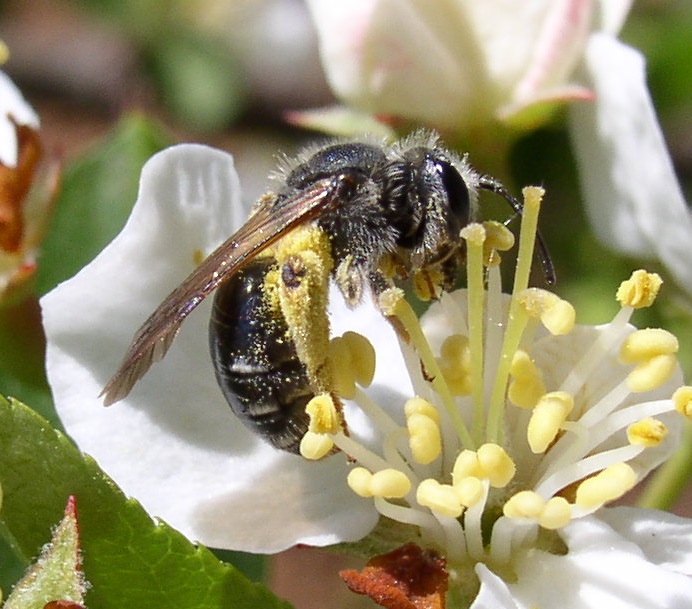|
Andrena Auricoma
The golden-haired miner bee (''Andrena auricoma'') is a species of mining bee, miner bee in the family Andrenidae. The female bees are 8 to 10 mm in length, and males are 6 to 9 mm long. It is found in the western United States, and is relatively rare outside California. It looks very similar to the Andrena astragali, death camas miner bee (''Andrena astragali'') but is smaller. References Further reading * * * Andrena, auricoma Insects described in 1879 {{Andreninae-stub ... [...More Info...] [...Related Items...] OR: [Wikipedia] [Google] [Baidu] |
Mining Bee
''Andrena'' is a genus of bees in the family Andrenidae. With over 1,500 species, it is one of the largest genera of animals. It is a strongly monophyletic group that is difficult to split into more manageable divisions; currently, ''Andrena'' is organized into 104 subgenera. It is nearly worldwide in distribution, with the notable exceptions of Oceania and South America. Bees in this genus are commonly known as mining bees due to their ground-nesting lifestyle. Morphology ''Andrena'' are generally medium-sized bees; body length ranges between 8 and 17 mm with males being smaller and more slender than females. Most are black with white to tan hair, and their wings have either two or three submarginal cells. They carry pollen mainly on femoral scopal hairs, but many ''Andrena'' have an additional propodeal corbicula for carrying some pollen on their thorax. C. D. Michener (2007) ''The Bees of the World'', 2nd Edition, Johns Hopkins University Press. They can be distin ... [...More Info...] [...Related Items...] OR: [Wikipedia] [Google] [Baidu] |
Andrenidae
The Andrenidae (commonly known as mining bees) are a large, nearly cosmopolitan family of solitary, ground-nesting bees. Most of the family's diversity is located in temperate or arid areas (warm temperate xeric). It includes some enormous genera (e.g., ''Andrena'' with over 1300 species, and '' Perdita'' with over 700). One of the subfamilies, Oxaeinae, is so different in appearance that they were typically accorded family status, but careful phylogenetic analysis reveals them to be an offshoot within the Andrenidae, very close to the Andreninae. C. D. Michener (2007) ''The Bees of the World'', 2nd Edition, Johns Hopkins University Press. Description The Andrenidae are typically small to moderate-sized bees, which often have scopae on the basal segments of the leg in addition to the tibia, and are commonly oligolectic (especially within the subfamily Panurginae). They can be separated from other bee families by the presence of two subantennal sutures on the face, a primitive ... [...More Info...] [...Related Items...] OR: [Wikipedia] [Google] [Baidu] |
Andrena Astragali
''Andrena astragali'', the death camas miner bee or death camas bee, is a species of miner bee in the family Andrenidae. It is found in North America. It specializes in feeding on the highly poisonous ''Toxicoscordion venenosum'', the meadow deathcamas, and close relatives. It is quite likely the only bee that can tolerate the deathcamas toxin, zygacine. Taxonomy and phylogeny ''A. astragali'' is a bee, a species in the order Hymenoptera, which includes wasps, bees, and ants. It is in the family Andrenidae, and the subfamily Andreninae. Its genus, ''Andrena'', is one of the largest genus of bees and its members are solitary ground dwelling mining bees. The species was first described by two entomologists with the University of Colorado Boulder, Henry Lorenz Viereck and Theodore D. A. Cockerell, who published the first description of the species in 1914. It was inadvertently named a second time as ''Andrena zygadeni'' by Cockerell from specimens collected in California fe ... [...More Info...] [...Related Items...] OR: [Wikipedia] [Google] [Baidu] |
Andrena
''Andrena'' is a genus of bees in the family Andrenidae. With over 1,500 species, it is one of the largest genera of animals. It is a strongly monophyletic group that is difficult to split into more manageable divisions; currently, ''Andrena'' is organized into 104 subgenera. It is nearly worldwide in distribution, with the notable exceptions of Oceania and South America. Bees in this genus are commonly known as mining bees due to their ground-nesting lifestyle. Morphology ''Andrena'' are generally medium-sized bees; body length ranges between 8 and 17 mm with males being smaller and more slender than females. Most are black with white to tan hair, and their wings have either two or three submarginal cells. They carry pollen mainly on femoral scopal hairs, but many ''Andrena'' have an additional propodeal corbicula for carrying some pollen on their thorax. C. D. Michener (2007) ''The Bees of the World'', 2nd Edition, Johns Hopkins University Press. They can be distin ... [...More Info...] [...Related Items...] OR: [Wikipedia] [Google] [Baidu] |

